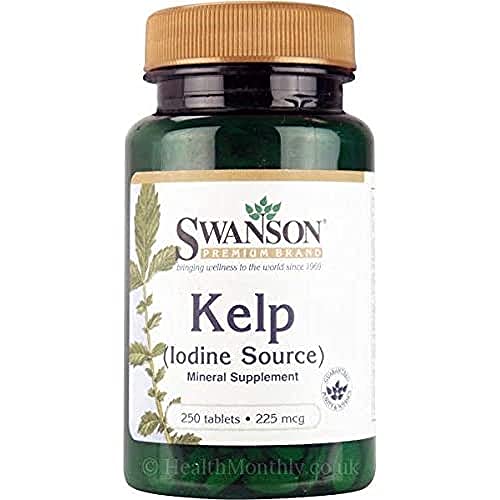The Laminariales (usually called kelp) are an order of brown algae of the Feoficee class. The order includes about a hundred species, many of which are known by the common name of laminaria (in the broadest sense – properly “laminaria” means the genus Laminaria, which gave the order its name).
If you wish to discover more specifics of kelp, then you definitely came to the right place. Purchasing a very good kelp requires analysis and to ensure making the best selection, and we wish to help you to achieve this task with success.
Table of Contents
- 1 What is the best kelp to buy?
- 2 Features
- 3 Distribution
- 4 Economic importance
- 5 Cultivation
- 6 Taxonomy
- 7 Best Kelp Reviews
- 8 Offers and Discounts
- 9 Cheap Kelp
- 10 Buy Kelp Online
- 10.1 Nature's Way Kelp 600 mg Non-GMO Project Verified Gluten Free Vegetarian; 180 Count (Packaging May Vary)
- 10.2 NOW Supplements, Kelp 325 mcg of Natural Iodine, Supports Healthy Thyroid Function*, Super Green, 250 Veg Capsules
- 10.3 Starwest Botanicals Organic Kelp Powder, 1 Pound
- 10.4 Oregon's Wild Harvest, Certified Organic Kelp Capsules with Iodine, Herbal Supplement, 90 Ct
- 10.5 Swanson Kelp Iodine Source 225 mcg 250 Tabs
- 10.6 Kelp Powder 1 Lb, Natural Iodine Supplement (High Fiber) Raw Kelp Seaweed Extract from Canada, 100% Pure, non-GMO, Gluten-free & Kosher
- 10.7 Nature's Sunshine Kelp 100 Capsules
- 10.8 Sea Tangle - Kelp Noodles - 3 Pack - 12 oz. each
- 10.9 Nature's Kelp Meal for Animals, 40 LBs
- 10.10 The Biology and Ecology of Giant Kelp Forests
- 11 Best Kelp 2025
- 12 References
What is the best kelp to buy?
Here is the top rated selected item of other customers acquiring items related to kelp. To get more possibilities, take a look at our full catalog of Kelp or use the search box.
Features
Usually the body (evolved thallus, called cormoid) consists of laminar structures similar to leaves, supported by elongated stems (jambs). A structure similar to a root (rhizoid) still the algae at the bottom.
There are frequent gas-filled blisters (aerocysts or pneumatocysts) that support the plant and bring the branches closer to sunlight. These blisters are also common in other orders of brown algae, e.g. in Rifles.
The reproduction, as in all algae, takes place by means of spores. The life cycle is haplodiplon with dominant sporophyte.
The laminaria can form vegetal associations called “prairies” (or also “forests”, for the bigger species).
Larger laminaria (e.g. Macrocystis pyrifera, Nereocystis luetkeana) can reach heights of 20-30m (in exceptional cases over 50m).
Distribution
The Laminariali are seaweeds, spread in all the seas of the world, usually close to the coasts.
The ideal habitat for the Laminariali is constituted by shallow waters, rich in nutrients and not too hot (below 20 °C). These conditions can be found, for example, along the coasts of California, where the climate is sunny but the water is made cooler by the California Current.
Economic importance
Kitchen
Many laminarie are edible.
Among these, the kombu algae widely used in Japanese cuisine – properly Saccharina japonica (sin. Laminaria japonica), sometimes replaced by other related species, e.g. Laminaria digitata, is particularly important. Another brown seaweed used in Japanese cuisine is Undaria pinnatifida (wakame), which always belongs to the Laminariali order but to a different family (Alariacee). Still to another family (Lessoniacee) of the same order belongs the arame (Ecklonia bicyclis).
Note that Japanese cuisine also makes use of algae belonging to other taxonomic groups, e.g. hijiki seaweed, which is a brown seaweed of the order Fucali, and nori seaweed, which is a red seaweed.
Saccharina japonica is also used in Korean cuisine, e.g. in seaweed spaghetti (cheonsa-chae). This species has also spread in relatively recent times (first half of the 20th century) to Chinese cuisine.
In Greenland, Iceland and the British Isles, the food consumption of Alaria esculenta, algae similar to Japanese wakame, is traditional.
Herbalism and cosmetics
Laminarie are used as dietary supplements in herbal medicine and dietetics.
They are also used as creams in cosmetics.
Livestock feeding
Along the Atlantic coasts of France, where there are massive tides, the algae left by the tide (a mixture of various species including mainly laminar) are harvested (goémon) and used to feed livestock.
Industrial raw material
Laminarie are widely used for the industrial production of alginates.
In addition, together with other groups of algae, they are raw material for the extraction of iodine.
Cultivation
Since the 1950s, Saccharina japonica has not only been harvested in the wild throughout the East, but also cultivated, with production now exceeding 700,000 tons per year.
The cultivation, destined both for food and industrial uses, takes place by growing the plants on ropes.
Taxonomy
The order includes over a hundred species divided into 8 or 9 families:
- Agaraceae Postels & Ruprecht (approx. 10 species)
- Akkesiphycaceae H.Kawai & H.Sasaki (1 species)
- Alariaceae Setchell & N.L.Gardner (approx. 20 species)
- Arthrothamnaceae (AlgaeBase only)
- Aureophycaceae (only AlgaeBase) (1 species)
- Chordaceae Dumortier (approx. 4 species)
- Costariaceae .E.Lane, C.Mayes, Druehl & G.W.Saunders (WoRMS only) (approx. 10 species)
- Laminariaceae Bory de Saint-Vincent (approx. 60 species)
- Lessoniaceae Setchell & Gardner (approx. 30 species)
- Pseudochordaceae Kawai & Kurogi (2 species)
Many individuals have used the kelp previously, so you can take full advantage of what they should say regarding it. If you want to learn what other people have to say about kelp, continue reading this short article.
Best Kelp Reviews
To help you, we have collected some interesting items that may help you make an informed selection relating to kelp.















